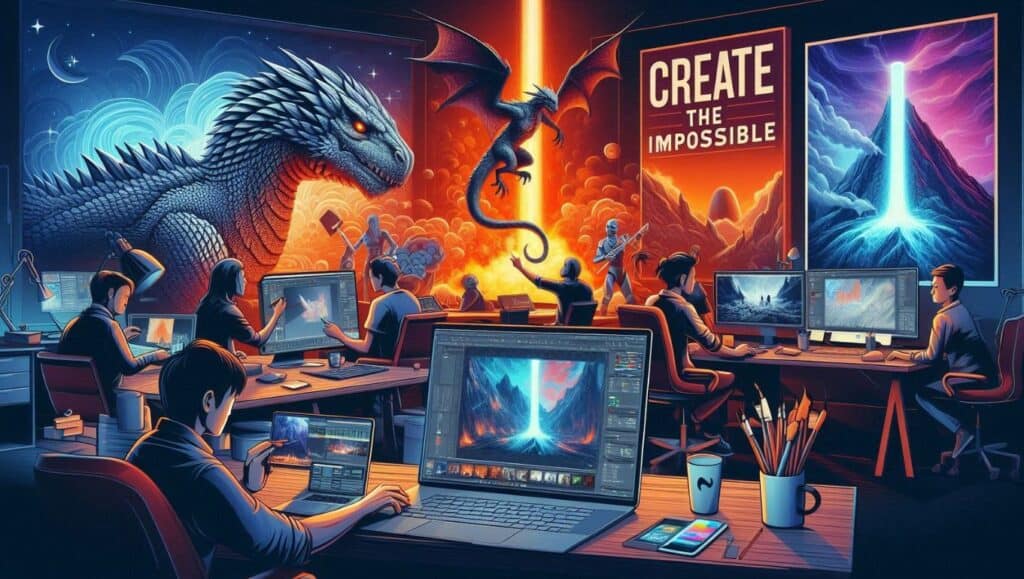Computer-generated imagery (CGI) has revolutionized the visual landscape across multiple industries, from blockbuster CGI movies to cutting-edge video games, immersive advertising, and beyond. As we step into 2025, the CGI software market has exploded with options catering to every skill level—whether you’re a curious beginner or a seasoned professional seeking advanced tools.
The digital design ecosystem has transformed dramatically, offering unprecedented opportunities for creative professionals to bring imagination to life. CGI is no longer just a technical skill—it’s an art form that bridges creativity and technology, enabling designers to craft visual experiences that were once impossible to conceive.
This comprehensive guide explores the 13 best CGI video editing software options that will empower your creative journey, breaking down complex tools into accessible insights for designers at every stage of their career.
Table of Contents
- What is CGI Software and Why is it Important in animation?
- 13 Best CGI Video Editing Software for Every Skill Level
- 6 Key Features to Consider When Choosing CGI Software
- FAQs
- 1. What is the best CGI software for beginners?
- 2. Is there free CGI software with professional capabilities?
- 3. Which software is most widely used in the film industry?
- 4. What are the key features to look for in CGI software?
- 5. What CGI software is best for creating 3D animations?
- 6. Are there CGI tools suitable for game design?
- 7. What is the difference between 2D and 3D CGI software?
- 8. Which CGI software is best for creating visual effects (VFX)?
- 9. Are there mobile apps for CGI design?
- 10. What is the best software for character modeling and animation?
- Conclusion
What is CGI Software and Why is it Important in animation?
Computer-Generated Imagery (CGI) software is a toolkit that allows designers, animators, and visual artists to create stunning digital imagery through computer algorithms. These powerful applications enable professionals to:
- Generate intricate 2D and 3D models
- Create complex animations
- Develop realistic visual effects
- Design immersive digital environments
- Create educational tutorials
- Prototype and visualize conceptual ideas
13 Best CGI Video Editing Software for Every Skill Level
Below is a curated list of 13 CGI animation software for varying skill levels, their standout features, pros, and ideal users.
1. Autodesk Maya

Autodesk Maya stands as a cornerstone of professional 3D animation and visual effects software, with a legacy spanning over two decades in the entertainment and design industries. Originally developed by Alias Systems Corporation and acquired by Autodesk in 2005, Maya has been the backbone of groundbreaking visual effects in blockbuster films like “Avatar,” “Lord of the Rings,” and countless animated productions from Pixar, DreamWorks, and other industry leaders.
Top Features:
- Advanced character rigging
- Comprehensive animation tools
- Powerful rendering capabilities
- Extensive plugin ecosystem
Pros:
- Industry-leading reputation
- Extremely versatile
- Regular software updates
Cons:
- Steep learning curve
- Expensive licensing
Best For: Professional animators, VFX artists, game developers
2. Blender
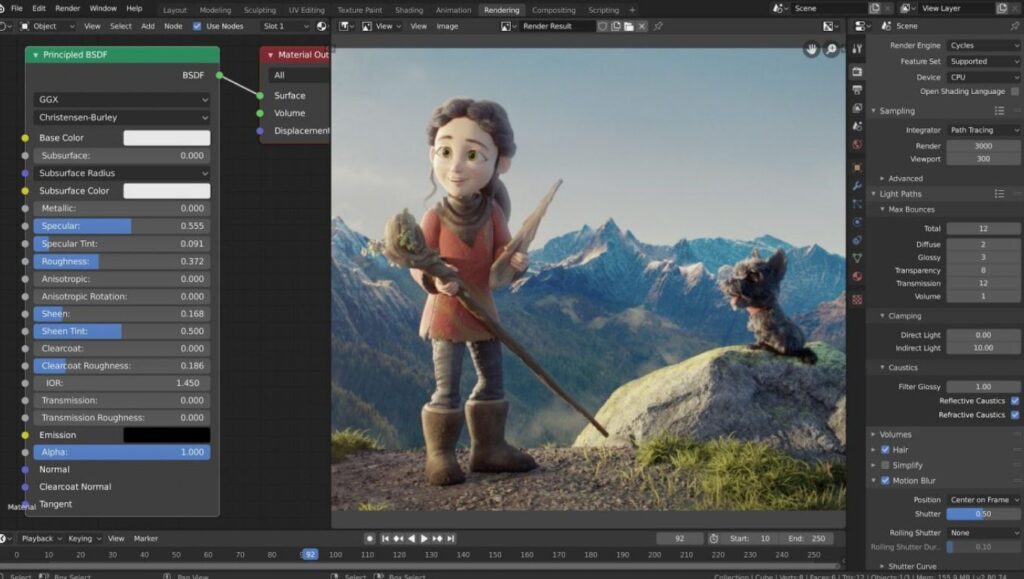
Blender represents a revolutionary approach to 3D software, emerging as a free, powerful, fully open-source platform that has dramatically transformed the digital creative landscape. Developed initially in 1994 by the Dutch animation studio NeoGeo, Blender underwent a remarkable transformation in 2002 when it became an open-source project through a groundbreaking community-funded initiative. Today, it stands as a comprehensive 3D creation suite that challenges commercial software with its robust feature set, active global community, and continuous innovation driven by passionate developers and artists worldwide.
Top Features:
- Complete 3D production pipeline
- Advanced sculpting and modeling tools
- Real-time physically-based rendering
- Integrated video editing and compositing
- Comprehensive animation and rigging systems
- Built-in game engine and physics simulations
Pros:
- Completely free and open-source
- Constant updates and improvements
- Cross-platform compatibility
- Extensive community support
- Versatile across multiple creative disciplines
Cons:
- Steeper learning curve for beginners
- Less industry-standard in some professional environments
- Interface can feel overwhelming initially
Best For: Independent creators, students, indie game developers, animation enthusiasts, and professionals seeking a cost-effective 3D solution
3. Cinema 4D
Developed by MAXON Computer GmbH, Cinema 4D has established itself as the premier software for motion graphics, design visualization, and creative 3D workflows. Launched in 1990, the software has consistently evolved to become the go-to solution for graphic designers, broadcast professionals, and creative agencies seeking an intuitive yet powerful 3D toolset. Its seamless integration with Adobe Creative Suite and exceptional user-friendly interface have made it a cornerstone of modern digital design, particularly in advertising, television, and multimedia production.
Top Features:
- Intuitive MoGraph module
- Procedural modeling tools
- Advanced character animation systems
- Physical rendering capabilities
- Seamless Adobe Creative Suite integration
- Robust VFX and simulation tools
Pros:
- Exceptionally user-friendly interface
- Powerful motion graphics capabilities
- Excellent Adobe ecosystem integration
- Regular, innovative updates
- Strong community and learning resources
Cons:
- Higher price point compared to some alternatives
- Less comprehensive for full 3D production pipelines
- Specialized strengths may limit broader applications
Best For: Motion graphics designers, broadcast professionals, advertising creatives, and multimedia artists
4. Houdini

Developed by Side Effects Software, Houdini represents the pinnacle of procedural 3D software, revolutionizing visual effects and technical animation since its inception. Emerging from the visual effects research community in the early 1990s, Houdini has become the industry standard for creating complex, dynamic simulations and effects in blockbuster films, television, and high-end visual productions. Its node-based workflow offers unprecedented flexibility and control, enabling artists to create intricate, parametric systems that can be easily modified and scaled.
Top Features:
- Node-based procedural workflow
- Advanced fluid and particle simulations
- Comprehensive destruction and environmental effects
- Powerful rendering capabilities
- Extensive Python scripting support
- Robust VFX toolset
Pros:
- Unparalleled procedural effect capabilities
- Extreme technical control and flexibility
- Used in major film and television productions
- Highly scalable and customizable
- Strong technical community
Cons:
- Steep learning curve
- Expensive licensing
- Overwhelming for beginners
- Requires significant technical understanding
Best For: Visual effects artists, technical directors, advanced 3D professionals, and studios working on complex simulations
5. 3ds Max

Autodesk 3ds Max has been a fundamental tool in architectural visualization, game design, and technical illustration since its introduction in 1996. Developed by Autodesk, the software has consistently pushed the boundaries of digital design, offering robust modeling, rendering, and animation tools that cater to professionals across various industries. Its comprehensive toolset has made it indispensable for creating detailed architectural renderings, mechanical designs, and immersive game environments.
Top Features:
- Advanced architectural modeling tools
- Comprehensive rendering capabilities
- Extensive plugin support
- Robust animation systems
- Parametric modeling
- Advanced material creation tools
Pros:
- Highly specialized for architectural visualization
- Strong game design capabilities
- Extensive third-party plugin ecosystem
- Regular software updates
- Comprehensive learning resources
Cons:
- Expensive licensing
- Complex interface
- High system resource requirements
- Steeper learning curve for beginners
Best For: Architectural visualizers, game designers, industrial designers, and technical illustration professionals
6. ZBrush

Pixologic’s ZBrush has fundamentally transformed digital sculpting by introducing a revolutionary approach to 3D modeling that mimics traditional sculpting techniques. Since its release in 2000, ZBrush has become the industry standard for high-resolution organic modeling, particularly in character design, creature creation, and digital sculpture. Its unique “pixol” technology allows artists to create incredibly detailed models with unprecedented artistic control.
Top Features:
- High-resolution digital sculpting
- Unprecedented surface detail capabilities
- Customizable brush creation
- Real-time rendering
- Advanced texture painting
- Massive brush and tool library
Pros:
- Unmatched organic modeling capabilities
- Used in major film and game productions
- Intuitive sculpting workflow
- Extensive creative possibilities
- Regular feature updates
Cons:
- Specialized tool with limited full pipeline capabilities
- Steep learning curve
- Higher price point
- Requires powerful hardware
Best For: Character artists, creature designers, digital sculptors, film and game industry professionals
7. KeyShot
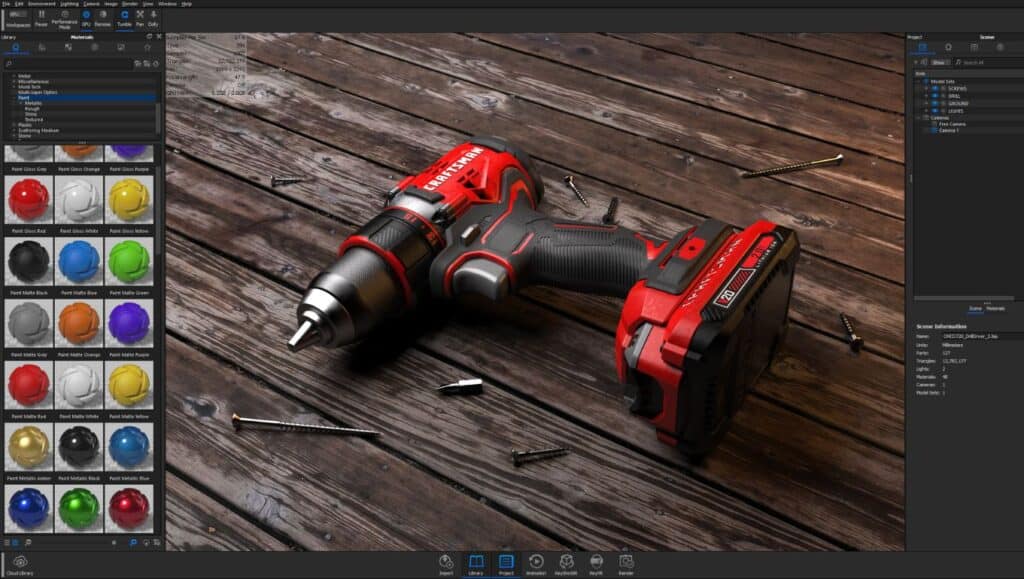
Developed by Luxion, KeyShot represents a breakthrough in real-time rendering technology, offering photographers, designers, and engineers an unprecedented tool for creating photorealistic visualizations. Launched in 2010, the software has rapidly become essential for product design, industrial visualization, and marketing professionals seeking high-quality, instantaneous rendering solutions. Its user-friendly interface and powerful rendering engine enable users to create complex material interactions and accurate lighting simulations with minimal technical expertise.
Top Features:
- Real-time physically accurate rendering
- Extensive material library
- Simple, intuitive interface
- CAD software integration
- Advanced lighting simulation
- Quick material and environment adjustments
Pros:
- Incredibly user-friendly
- Instantaneous rendering results
- High-quality output
- Broad industry application
- Seamless CAD integration
Cons:
- Limited advanced 3D modeling tools
- Focused primarily on rendering
- Higher price point for professional versions
- Less comprehensive compared to full 3D suites
Best For: Product designers, industrial designers, marketing professionals, and visualization experts
8. Lightwave 3D
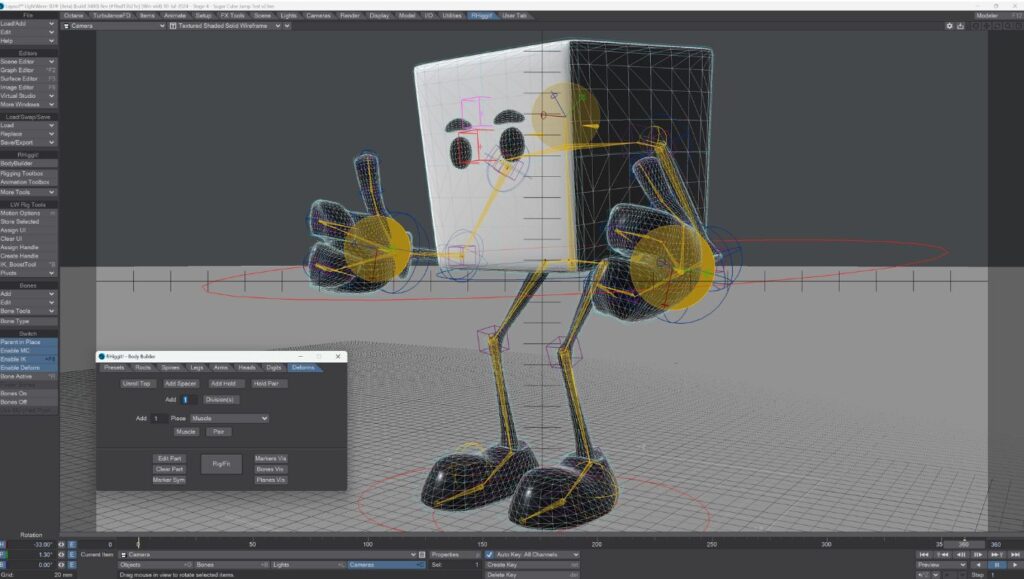
LightWave 3D, developed by NewTek, has been a cornerstone of CGI and visual effects production since its inception in the late 1980s. Originally renowned for its groundbreaking work in television visual effects, particularly in series like “Babylon 5,” the software has evolved into a comprehensive 3D modeling and animation solution. LightWave has maintained a strong reputation in industries ranging from broadcast graphics to architectural visualization, offering a robust set of tools for professional 3D animation and rendering.
Top Features:
- Advanced rendering capabilities
- Comprehensive 3D modeling toolkit
- Powerful animation systems
- Node-based material creation
- Real-time viewport rendering
- Extensive plugin support
Pros:
- Long-standing industry reputation
- Competitive pricing
- Strong visualization tools
- Relatively gentle learning curve
- Consistent software updates
Cons:
- Less extensive industry adoption compared to Maya
- Limited integration with some CAD systems
- Smaller community compared to major 3D platforms
Best For: Broadcast designers, independent animators, architectural visualizers
9. Modo
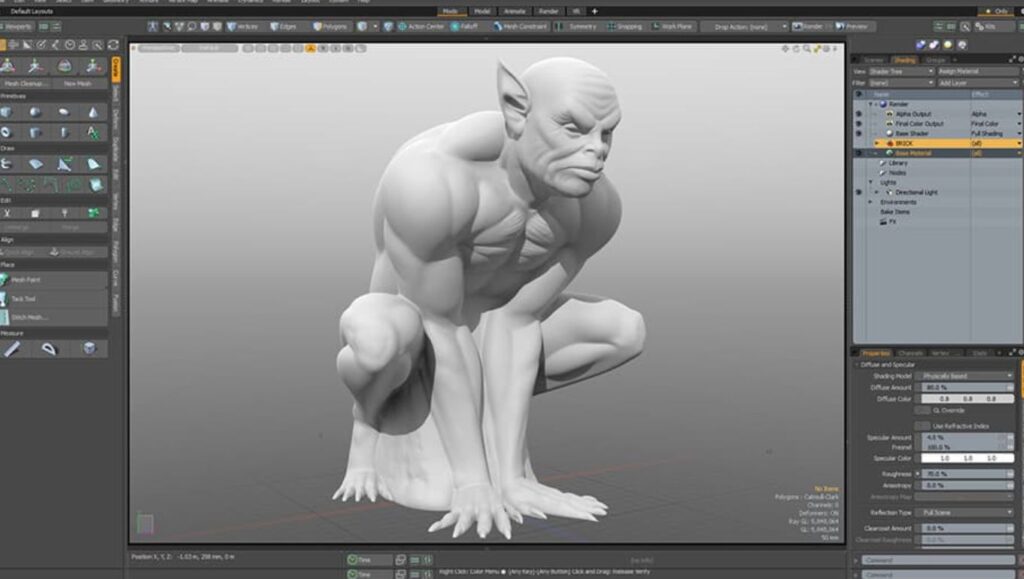
Developed by Foundry, Modo represents a revolutionary approach to 3D modeling and design, offering an intuitive workflow that bridges the gap between traditional 3D software and modern creative processes. Since its launch in 2005, Modo has distinguished itself through its innovative modeling tools, robust rendering capabilities, and a flexible interface that appeals to both design professionals and creative enthusiasts engaged in CGI and 3D animation projects.
Top Features:
- Advanced polygon and subdivision modeling
- Integrated sculpting tools
- Powerful rendering engine
- Procedural modeling capabilities
- Comprehensive material system
- Robust animation tools
Pros:
- Exceptional modeling workflow
- Intuitive user interface
- High-quality rendering
- Flexible design approach
- Strong GPU rendering support
- Offers free trial
Cons:
- Higher learning curve for beginners
- More expensive professional versions
- Less extensive in specialized VFX workflows
Best For: Product designers, industrial designers, 3D modeling professionals
10. Rhino
Rhinoceros 3D, commonly known as Rhino, has established itself as a premier precision modeling software primarily used in industrial design, architecture, and engineering. Developed by Robert McNeel & Associates, Rhino offers unparalleled accuracy in creating complex geometric forms, making it an essential tool for professionals requiring mathematical precision in their 3D modeling workflows.
Top Features:
- NURBS mathematical modeling
- Extensive plugin ecosystem
- Precise geometric construction
- Cross-platform compatibility
- Advanced surface modeling
- Integration with CAD and manufacturing tools
Pros:
- Exceptional geometric accuracy
- Versatile across multiple industries
- Extensive third-party plugin support
- Relatively affordable licensing
- Strong educational resources
- Offers free trial
Cons:
- Limited built-in rendering capabilities
- Less intuitive for organic modeling
- Requires additional plugins for comprehensive workflows
Best For: Industrial designers, architects, engineers, parametric design professionals
11. Clarisse iFX
Developed by ISOTROPIX, Clarisse iFX represents a next-generation approach to CGI rendering and scene management. Specifically designed for high-end visual effects and animation production, the software has been instrumental in creating complex scenes for major film and television productions. Its unique scene management and rendering capabilities set it apart in the professional visual effects landscape.
Top Features:
- Advanced scene management
- Real-time rendering capabilities
- Massive scene handling
- Procedural content generation
- Complex lighting simulations
- Extensive shader and material systems
Pros:
- Exceptional performance with large scenes
- Innovative rendering technology
- Used in major film productions
- Highly scalable workflows
- Advanced lighting solutions
Cons:
- Steep learning curve
- Higher price point
- Requires significant computational resources
- Specialized professional focus
Best For: High-end visual effects artists, film production studios, complex scene designers
12. DAZ Studio
DAZ Studio has emerged as a premier platform for 3D character creation and animation, offering both professional and amateur creators an accessible toolkit for developing detailed digital characters. The software provides an extensive library of pre-built models, morphing capabilities, and intuitive character generation tools that simplify the complex process of 3D character design.
Top Features:
- Extensive character model library
- Advanced morphing capabilities
- Robust pose and animation tools
- High-quality texture mapping
- Multiple render engine support
- Extensive community resources
Pros:
- Free base software
- Beginner-friendly interface
- Comprehensive character creation tools
- Large model and asset marketplace
- Strong community support
Cons:
- Limited advanced modeling tools
- Requires additional purchases for premium content
- Less suitable for complex scene creation
- Primarily focused on character design
Best For: Character designers, digital artists, hobbyist 3D creators, game asset developers
13. Poser
Poser, developed by Smith Micro Software, has long been a staple in digital character creation and animation. Specifically designed to make character posing, animation, and rendering accessible, Poser has served artists, illustrators, and digital content creators across various industries. Its user-friendly approach democratizes complex character animation techniques.
Top Features:
- Extensive character pose tools
- Comprehensive character library
- Advanced rigging systems
- Multiple render engine support
- Facial animation capabilities
- Morphing and texture painting tools
Pros:
- Intuitive character animation workflow
- Accessible for beginners
- Extensive content marketplace
- Multiple export options
- Strong community resources
Cons:
- Limited advanced modeling capabilities
- Less suitable for complex scene creation
- Requires additional content purchases
- Relatively specialized functionality
Best For: Digital artists, illustrators, character designers, independent content creators
6 Key Features to Consider When Choosing CGI Software
Choosing the right CGI software can be daunting, but focusing on key features simplifies the decision. Whether you’re a beginner or a pro, factors like ease of use, rendering speed, and integration capabilities play a crucial role. Here, we’ll explore six essential features to ensure your investment aligns with your creative needs.
1. User Interface and Ease of Use
A well-designed CGI software interface is critical for efficient workflow and creative productivity. The most effective platforms offer an intuitive, customizable workspace that adapts to individual user preferences and skill levels. Comprehensive tutorial libraries and learning resources should be readily available, supporting users from initial exploration through advanced technique mastery.
2. Rendering Capabilities and Speed
Rendering quality represents the fundamental differentiator between amateur and professional CGI software solutions. Superior software provides high-fidelity output with minimal computational overhead, supporting multiple render engines and delivering photorealistic results efficiently. Advanced rendering capabilities should balance processing speed with exceptional visual quality, enabling creators to generate complex scenes without prohibitive time investments.
3. Special Effects and Animation Tools
Sophisticated CGI software distinguishes itself through advanced character rigging and animation capabilities that simulate realistic movement and interaction. Comprehensive particle and simulation systems allow creators to generate complex environmental effects, from fluid dynamics to atmospheric phenomena. Integrated motion capture support further enhances the software’s ability to translate real-world movement into digital animations with unprecedented precision.
4. Software Integration
Effective CGI software must function seamlessly within broader digital creative ecosystems, offering robust compatibility with diverse design tools and file formats. Advanced platforms provide sophisticated import and export capabilities, ensuring smooth workflow transitions between different software environments. Extensive plugin support allows users to customize and extend the software’s native functionality, creating a more versatile and personalized creative experience.
5. Licensing and Price Points
Modern CGI software licensing models have evolved to accommodate diverse user needs, ranging from subscription-based access to perpetual licensing options. Educational institutions and students benefit from significant discounts, making professional-grade tools more accessible to emerging talent. Most reputable software providers offer comprehensive free trial periods, enabling potential users to thoroughly evaluate the platform’s capabilities before making a financial commitment.
6. Community Support
A robust and active user community represents a critical supplement to formal software documentation and technical support. The most valuable CGI software platforms maintain regularly updated forums, comprehensive online resources, and responsive support channels. Consistent software updates, driven by user feedback and technological advancements, ensure that the tool remains competitive and aligned with evolving industry standards and creative requirements.
FAQs
1. What is the best CGI software for beginners?
Blender is the top recommendation for beginners, offering a free, comprehensive platform with extensive online learning resources and a robust feature set for 3D modeling and animation. Its user-friendly interface and active community support make it ideal for those starting their CGI journey.
2. Is there free CGI software with professional capabilities?
Blender stands out as a free CGI software with professional-grade capabilities, used by studios for short films and animations. It provides advanced rendering, sculpting, and texturing tools that rival many paid software options.
3. Which software is most widely used in the film industry?
Autodesk Maya is the industry standard for film and visual effects, widely used by major studios like Pixar and DreamWorks. Its comprehensive toolset for character animation and advanced simulation capabilities make it the go-to software for professional film production.
4. What are the key features to look for in CGI software?
Essential features include an intuitive user interface, comprehensive modeling tools, advanced rendering capabilities, robust animation and rigging systems, and compatibility with industry-standard file formats. The software should also offer efficient workflow options and extensive customization.
5. What CGI software is best for creating 3D animations?
Autodesk Maya leads the pack for 3D animations, offering professional-grade tools and industry-standard capabilities. Blender and Cinema 4D are also excellent alternatives, providing versatile and user-friendly animation features for different skill levels.
6. Are there CGI tools suitable for game design?
Blender, Unity, and Unreal Engine are top CGI tools for game design, offering comprehensive 3D modeling, texturing, and animation capabilities. These platforms provide game developers with robust toolsets for creating detailed game assets and environments.
7. What is the difference between 2D and 3D CGI software?
2D CGI software focuses on creating flat, two-dimensional graphics and animations, while 3D CGI software allows for creating depth, volume, and complex spatial relationships. 3D software enables more intricate modeling, rendering, and animation with multiple dimensions.
8. Which CGI software is best for creating visual effects (VFX)?
Houdini is renowned for creating complex visual effects, offering advanced procedural workflows and powerful simulation tools. Autodesk Maya and Nuke are also industry-standard options for professional VFX production in film and television.
9. Are there mobile apps for CGI design?
Several mobile apps like Pixologic’s 3D Coat, Nomad Sculpt, and Adobe Capture provide basic CGI design capabilities on tablets and smartphones. These apps offer simplified modeling, sculpting, and design tools for on-the-go creativity.
10. What is the best software for character modeling and animation?
ZBrush is considered the premier software for character modeling, offering unparalleled digital sculpting tools and intricate detailing capabilities. For animation, Autodesk Maya provides comprehensive character rigging and animation systems used extensively in professional production.
Conclusion
Choosing the right CGI software depends on your goals and experience. Whether you’re a beginner exploring free tools like Blender or a professional mastering Autodesk Maya, experimenting is key. With CGI’s growing influence in industries, learning these tools could open doors to exciting careers. Start your journey today with the software that best suits your needs!

